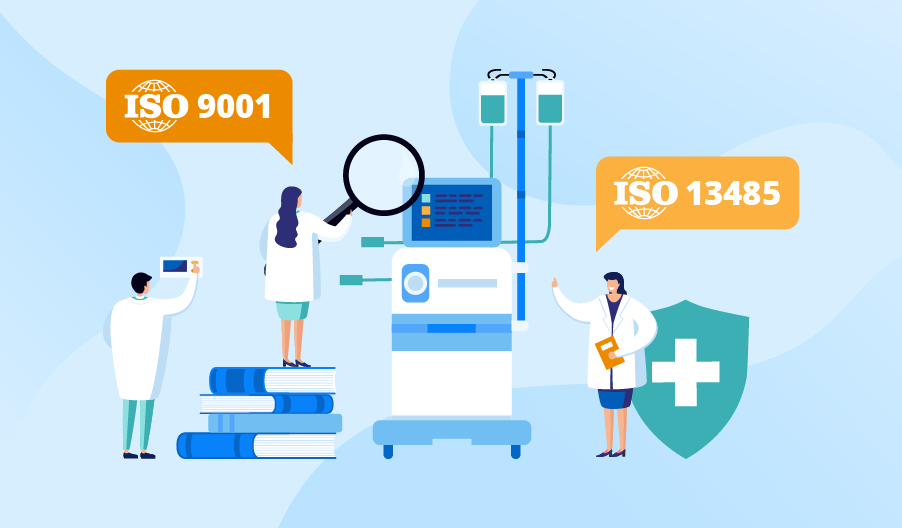ISO 13485 vs. ISO 9001: Similarities and Differences

Editor’s note: Gala compares ISO 9001 and ISO 13485 and explains how to understand which of these standards is right for your medical device manufacturing organization. If you want to know how to implement a quality management system (QMS) in accordance with ISO 9001 or ISO 13485, you are welcome to turn to ScienceSoft’s team for healthcare IT consulting.
The quality management system (QMS) covers the full production cycle of the software or a device. To understand the difference between ISO 9001 and ISO 13485, let’s compare these international standards.
ISO 13485 and ISO 9001: the essence
ISO 9001
ISO 9001 is an international standard developed by the International Organization for Standardization (ISO) for the creation, implementation, and maintenance of QMS and aimed at increasing clients’ satisfaction with the quality of products or services. ISO 9001 can be followed by organizations regardless of the industry. The standard was revised several times and the latest version is ISO 9001:2015.
ISO 13485
ISO 13485 is the international quality management standard for medical devices. Its last revision took place in 2016. The requirements of ISO 13485:2016 were developed taking into account the need to ensure the safety of all stages of a medical device life cycle: design, production, operation, disposal, etc.
ISO 13485 and ISO 9001: similarities
Risk assessment
Both standards highlight the importance of incorporating risk management into the design and production stages and developing risk management strategy to minimize the possible negative consequences of risks.
Customer focus
Both ISO 13485 and ISO 9001 aim to make certain that customers are satisfied with the final product.
Quality improvement model
Although ISO 13485 and ISO 9001 don’t have the same structure, they both use a PDCA (Plan-Do-Check-Act) cycle, the continuous quality improvement model consisting of a logical sequence of four repetitive steps for continuous enhancement to a product or service.
Employee competency
To comply with either of these two standards, the medical device manufacturing organization must ensure that its employees are competent to carry out their assigned work.
ISO 13485 and ISO 9001: differences
In general, ISO 9001 standard can be used for various industries (e.g., manufacturing) but ISO 13485 applies exclusively to medical devices and Software as a Medical Device (SaMD). There are also other prominent differences:
Documentation control
ISO 13485, in comparison with ISO 9001, is more demanding in terms of documentation: it requires the inclusion of regulatory documents (detailed product specification, description of production processes, installation and maintenance processes) in the system documentation.
Distribution of duties
ISO 9001 allows organizations to distribute the responsibilities for quality control without being tied to specific managers, while ISO 13485 states that a medical device manufacturer must appoint a certain employee from the management to be responsible for QMS.
Risk management
ISO 13485 focuses on the development of documentation for risk management and requires a medical device manufacturer to maintain records of the risk management process during the medical device production. In addition, the standard obliges medical device manufacturers to analyze consumer complaints and establish after-sales supervision of the conformity of the product to the declared quality.
Quality requirements
For ISO 9001, customer satisfaction is the hallmark of a quality-oriented culture. ISO 13485 focuses on the safety of customers and, in addition to the quality-oriented culture, establishes specific safety requirements, e.g., during production (like sterility), assembly and packaging of each medical device, installation, inspection, and shelf life of medical devices.
Resource management
Resources, according to both standards, are defined as the various equipment, buildings, personnel, and IT resources required to create high-quality products. According to ISO 13485, the organization, which is involved in the full production cycle of medical devices, has to document the requirements for the health and the cleanliness of personnel clothing, monitor the production environment, and develop the systems for the containment of contaminated products.
Make your QMS compliant with international standards
If your company is engaged in the production and sales of medical devices at the international level, it would be logical to opt for ISO 13485. If your company isn’t sure that its healthcare software qualifies as SaMD and what certification is relevant in your case, our healthcare IT team will be glad to provide a consultation on how to improve your QMS and make it compliant with applicable international standards.
Launch your Project

Medical Device Software Development by ScienceSoft
Looking to develop medical device software? Our certified BAs, developers and QA specialists work together to deliver highly secure and reliable healthcare solutions.



